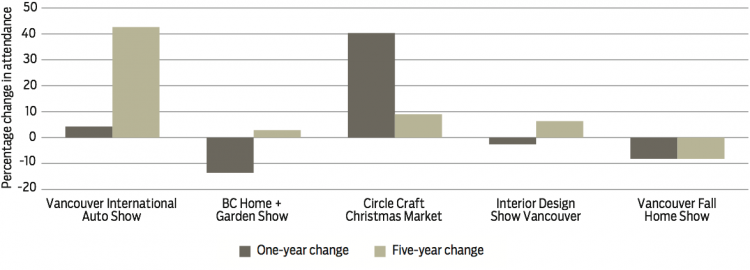Lower Mainland’s largest trade shows are growing at nine times the rate of the region’s largest consumer shows, according to data collected in Business in Vancouver’s lists of top trade and consumer shows (page 12).
Attendance at the province’s 11 largest trade shows has grown an average of 9% over the past year. During the same period, attendance at the largest consumer shows on BIV’s list grew an average of 1%.
Over the past year, more than 545,900 people attended Lower Mainland’s largest consumer shows, approximately eight times the 67,200 people who attended trade shows over the same period.
The B.C. Tech Summit recorded the largest trade show attendance growth on BIV’s list (63.6%), increasing to 9,000 attendees in 2018 from 5,500 attendees the year before. The increase nearly tripled that of the second-fastest-growing trade show, Education & Career Fairs – Vancouver, which grew 26%. B.C. Tech Summit’s significant attendance growth allowed it to jump to No. 3 in 2018 from No. 5 in 2017 on BIV’s list.

Three trade shows had declining attendance over the last year, including CHFA West and the Cargo Logistics Canada Expo and Conference. The Pacific Agriculture Show had the largest drop in trade show attendance, down 9.2% to 8,900 in 2018 from 9,800 in 2017.
Meanwhile, attendance at 40% of consumer shows was down at their most recent event compared with the previous year and 30% of trade shows drew fewer people this year compared with last year.

The Circle Craft Christmas Market had the largest attendance increase among the Lower Mainland’s top consumer shows. It increased its attendance by 40.4% to 40,000 at its most recent event compared with 28,500 at its previous event.
The second-largest consumer show in the region, the BC Home + Garden Show, recorded the largest drop in attendance. It fell 13.6% to 50,500 people in 2018 from 58,400 people in 2017. •




